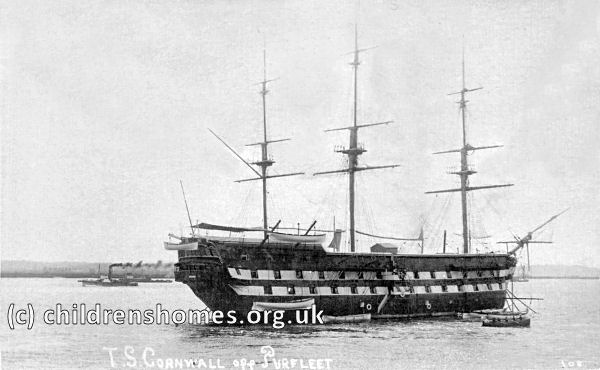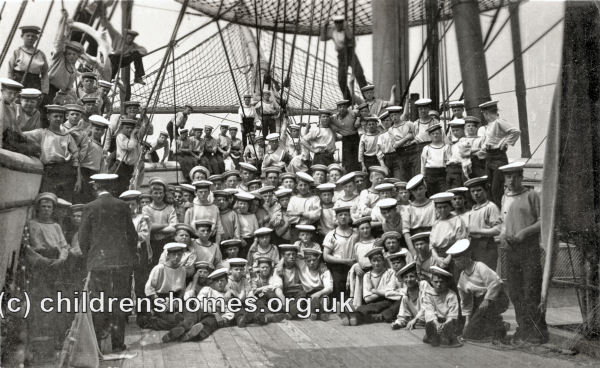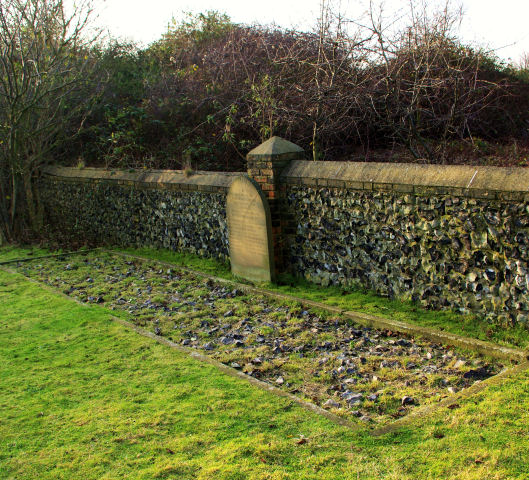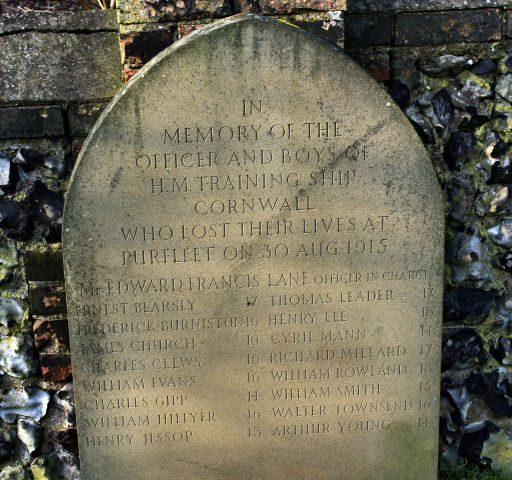Reformatory School Ship 'Cornwall', Purfleet, Essex
The Reformatory School Ship Cornwall was the third such establishment to be founded, following in the wake of the two Merseyside vessels, the Akbar and the Clarence. A London businessman, George Chambers, who had been impressed by the Akbar proposed that London would benefit from similar institution. The Admiralty offered to donate an old frigate, the Cornwall, for the purpose as long as money could raised to fit her out. The necessary £2,000 was soon raised by public donations. The Cornwall was moored on the River Thames off Purfleet in Essex. She was certified for operation on May 2, 1859, with the first boy being admitted the following month. The ship could accommodate up to 250 boys, aged 11 to 14, who had been committed to detention for at least three years. A payment of 2s. 6d. per week was required for each boy's outfit etc.
In 1868, the ship's committee discovered that the Wellesley, a receiving ship for the Royal Navy, based on the River Tyne, was about to be scrapped. They successfully petitioned the Admiralty to take over the vessel and in June 1868, the Cornwall and Wellesley switched places, and names. The 'new' Wellesley then moved up to Tyneside to become the Industrial School Ship Wellesley.

The Cornwall, c.1910. © Peter Higginbotham.
As well as learning nautical skills, boys on the Cornwall learned tailoring, and carpentry was later introduced. The ship later became noted for a proficiency in drawing. Boys could also develop musical skills in the ship's military band.
In the early 1900s, the Cornwall was involved in several scandals. In 1902, the ship's second officer, Henry Hunt, was stabbed by two boys named Percival and Rixon. In court, it eventually transpired that the two boys, together with three accomplices who had sharpened the knives, had stolen tins of corned beef from ship's stores room a few days before, and feared that they were about to be identified as the culprits by the ship's officers. The boys pleaded guilty to the charges and, begging for a second chance, were allowed to return to the ship.

Inmates of the Cornwall, c.1910. © Peter Higginbotham.
A second knife attack took place in 1903 when Mr Maine, a Seaman Instructor, was stabbed by two boys named Bennett and Flack. These two and four others received eighteen strokes with the birch. Maine, perhaps fearing reprisals, decided not to prosecute the boys. However, several of those involved were transferred to the Philanthropic Society's Reformatory at Redhill.
The Cornwall received further bad publicity when seven boys contracted typhoid. It was discovered that cheap blankets from army hospitals in South Africa, unwashed and infected, had been sold to the ship. These had been distributed to the boys, again without being cleaned.
On April 1st, 1908 the ship was certified to accommodate 275 boys. In 1926, it relocated a few miles down the Thames to a new mooring at Denton, near Gravesend, with her capacity now set at 200 places.
On Monday, August 30th, 1915, sixteen of the boys and an officer died after the sailing cutter Alert belonging to the Cornwall collided with the steam tug Empress on the Thames at Purfleet. It took a week to recover all the bodies. Ten other boys survived the sinking. A subsequent inquest heard an account of the incident from P.C. Smith who stated that:
The inquest was also told that despite having claimed to be able to swim, some of the boys involved had not passed the 40-yard swimming test required before they were officially allowed in such boats. After hearing conflicting evidence from those involved and other witnesses, the jury concluded the deaths had been accidental due to an error of judgment by the master of the tug. According to one estimate, the funeral of the victims was attended by four thousand people, with the ship's band leading the mile-long procession. The boys were buried in a communal plot in the churchyard at St Clement's Church, West Thurrock. Peter Horne has kindly provided pictures of the location.

TS Cornwall burial plot, West Thurrock. © Peter Horne.

TS Cornwall burial plot, West Thurrock. © Peter Horne.
The officer, Edward Francis Lane (referred to in some reports as Frederick Lane), was buried in a separate grave. The boys who died were:
| Ernest Bearsly (17), Ealing | Thomas Leader (17) | |
| Frederick Burniston (16), Sheffield | Henry Lee (16), Tottenham | |
| James Church (16), Ealing | Cyril Mann (14), Colchester | |
| Charles Clews (16), Coventry | Richard Millard (17) | |
| William Evans (16), Leyton | William Rowlands (18), Ramsgate | |
| Charles F. Gipp (14) | William J. Smith (15), Leyton | |
| William Hillyer (16), Manor Park | Walter Townsend (16), Leyton | |
| Henry Jessop (13), Deptford | Arthur Young (14) |
In around 1934, the ship became designated as an Approved School, one of the new institutions established by the 1933 Children and Young Persons Act.
In July 1939, growing concerns about the various aspects of establishment's operation, coupled with deteriorating condition of the ship, led to a decision that the Cornwall would be closed in 1941. A few weeks later, with the outbreak of the Second World War, the boys were evacuated to a Ministry of Labour Camp at Brandon in Suffolk. A breakdown of discipline at the camp was followed by the withdrawal of its certification and closure. In September 1940, the ship, still moored at Denton, was hit by a German bomb and was effectively written-off.
Records
Note: many repositories impose a closure period of up to 100 years for records identifying individuals. Before travelling a long distance, always check that the records you want to consult will be available.
- The National Archives, Kew, Richmond, Surrey, TW9 4DU. Mostly post-1900 items such as a very useful 1901 report, details on the evacuation to Suffolk in WW2 and newspaper clippings relating to the 1915 accident.
Bibliography
- Emeny, Andrew "Why was the Training Ship Cornwall established on the Thames and was it Successful?" in The Local Historian, Volume 53, No.2, April 2023, pp.144-150. (Read online)
- Millachip, Walter The Jubilee of the Training ship "Cornwall" off Purfleet, Essex : a short history of fifty years' reformatory work and its results 1859-1909. (1909, Eccles)
- Carridice, Phil Nautical Training Ships: An Illustrated History (2009, Amberley Press)
- Higginbotham, Peter Children's Homes: A History of Institutional Care for Britain's Young (2017, Pen & Sword)
Links
- None identified at present.
Except where indicated, this page () © Peter Higginbotham. Contents may not be reproduced without permission.


